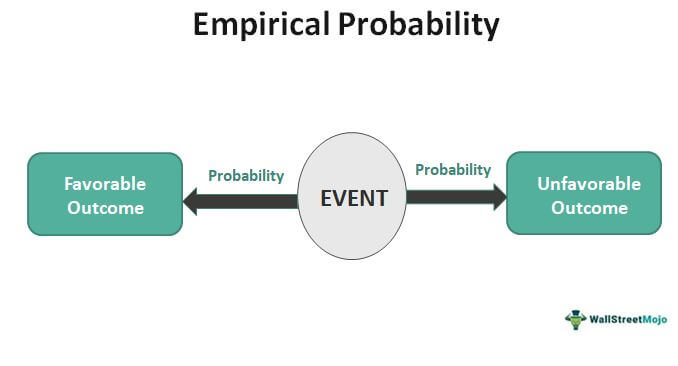Table Of Contents
What Is Empirical Probability?
Empirical Probability refers to the probability or likelihood of a particular event happening based on experiments rather than pre-conceived ideas. It is the ratio of the number of favorable outcomes to the total experiments performed. Empirical probability helps governments and businesses estimate the possibility of many outcomes.

Since this type of probability is backed by experimental evidence, not assumptions, it is considered reliable. Therefore, it is an important statistical tool considered very useful in economics. It is also used in other fields like chemistry and physics. Similar types of probability include theoretical, subjective, and conditional probability.
Key Takeaways
- Empirical or experimental probability is the estimation of the chances of the occurrence of a particular event based on experience.
- It differs from theoretical probability as it arrives at results through solid test-based evidence, while the latter is based on established mathematical ideas. In addition, the experimental probability is free of assumptions, principles, and hypotheses.
- It has significant applications in diverse fields. For example, empirical probability in business and the economy helps understand the chances of a particularly favorable or unfavorable outcome.
- This allows entities to introduce changes accordingly, with minimum negative impacts.
Empirical Probability Explained
Empirical probability formula has its foundation in mathematics. Experiments are conducted to find the chances of a particular outcome, and the number of times the favorable outcome occurred was recorded. Unlike theoretical probability, which uses historical or pre-determined, empirical probability depends on strictly experimental evidence.
Nowadays, other fields are increasingly adopting it, as there are a lot of numbers to deal with. Also, random assumptions and secondary data are insufficient to find concrete results. This is where experimental probability becomes helpful.
Empirical probability in business facilitates companies to gain insights about the occurrence of a certain activity or trend, like the acceptance of a new product. They can study this and incorporate the necessary modifications into their business by minimizing losses.
Governments, too, use this approach to understand economic activities and international affairs. For example, it can predict the reactions of different sections of society when it introduces new policies. Another example is when economists use experimental probability to predict election results.
Formula
The formula given here helps to find the experimental probability of an event:
Empirical Probability, P(E) = Number of favorable outcomes / Total experiments conducted
Some important points to remember:
- The value of experimental probability concluded through this formula will always lie between 0 and 1.
- If P(E) is equal to 0, it is concluded that the event is an impossible one.
- If P(E) is equal to 1, it is a certain event.
However, one should perform an adequate number of experiments to make these conclusions. Otherwise, it will not be dependable. For example, if a person tosses a coin five times and gets only heads each of the times, it does not mean that getting a tail while tossing a coin is impossible.
Calculation Example
Let’s work out an example to understand the use of experimental probability. Jane wants to find the probability of obtaining a tail while tossing an unbiased coin. Therefore, she decides to toss the coin 100 times and record the observations. Jane observed that she got tail 78 times and head 22 times.
Here, the number of favorable outcomes = 78
Total experiments = 100
Therefore, P(Obtaining tail while tossing a coin) = 78/ 100 = 0.78
Currently, many online empirical probability calculators help calculate the probability of events related to mathematics, physics, chemistry, finance, health, etc. Custom-made options for specific concepts are also available. Such calculators help experimenters to understand vast amounts of data.
Theoretical vs Empirical Probability
Having understood the concept of empirical probability, it is now important to differentiate it from classical or theoretical probability. The latter helps find the likelihood of an outcome using pre-determined ideas. Theoretical probability arrives at the chances of an event happening using the formula:
Theoretical Probability, P (T) = Number of favorable outcomes / Total number of possible outcomes
Consider the example of Jane, who tossed an unbiased coin 100 times to find the probability of getting tails. If we were to take the theoretical approach, she would’ve arrived at the following answer:
Probability (Getting a tail while tossing a coin 100 times) = (1/2)^100
This is because the classical approach establishes that tossing a coin has only two possible outcomes: heads or tails. It then confers an equal likelihood of both these outcomes, which makes the probability of one outcome ½. But we know from experiments that, in reality, this might not always be the case. Similarly, the established probability of obtaining a certain number while throwing a die is 1/6, according to classical probability.
Conditional And Subjective Probabilities
Now, let’s move on to understanding two other probability types – conditional and subjective. Conditional probability finds the chances of occurrence of an outcome, given a condition. For instance, in the example above, Jane considered an unbiased coin. However, if she decides to use a coin that is biased towards heads, the probability of obtaining a tail will be further low. This is a conditional probability.
Subjective probability is not quantifiable. It usually depends on people’s opinions and information gathered by them. Therefore, it is not concrete or corroborated by evidence. For example, a critic’s opinion about the success of a certain yet-to-be-released movie will depend on their conviction, professional experience, likes, and dislikes. They might even support their opinion with facts, but there cannot be any confirmations until the release of the movie.

